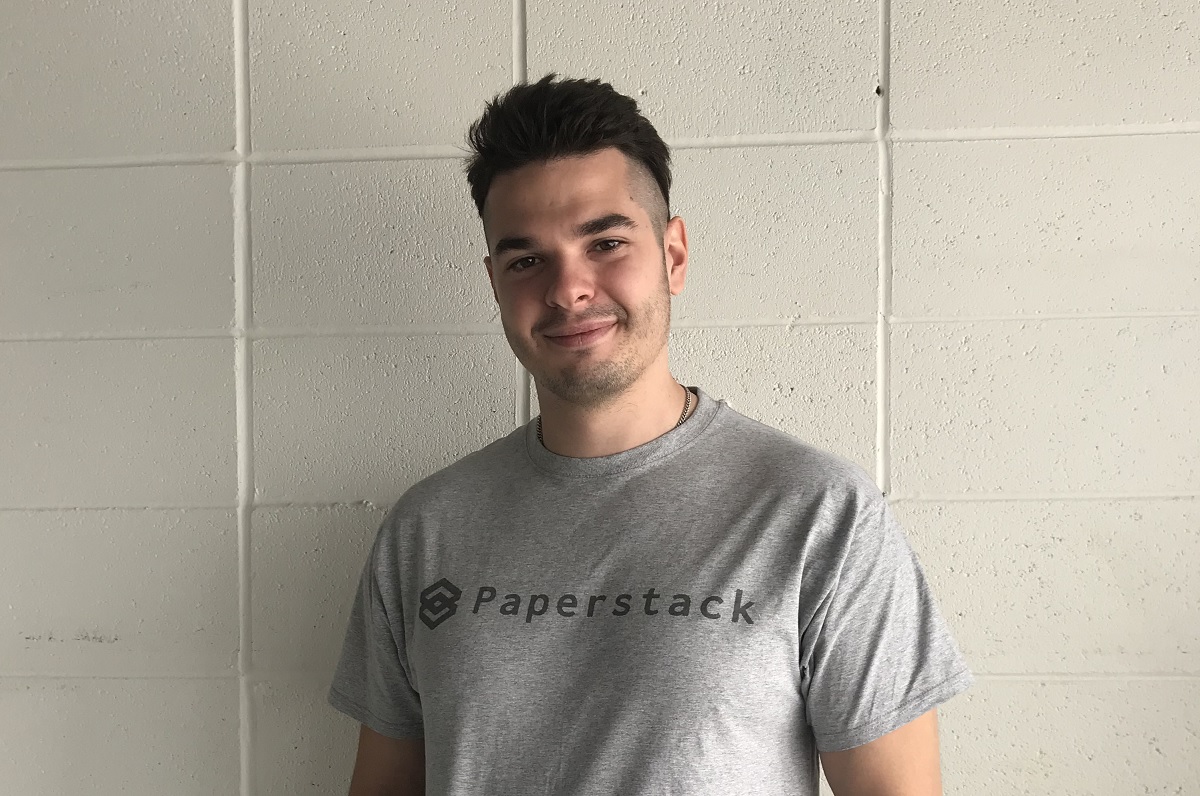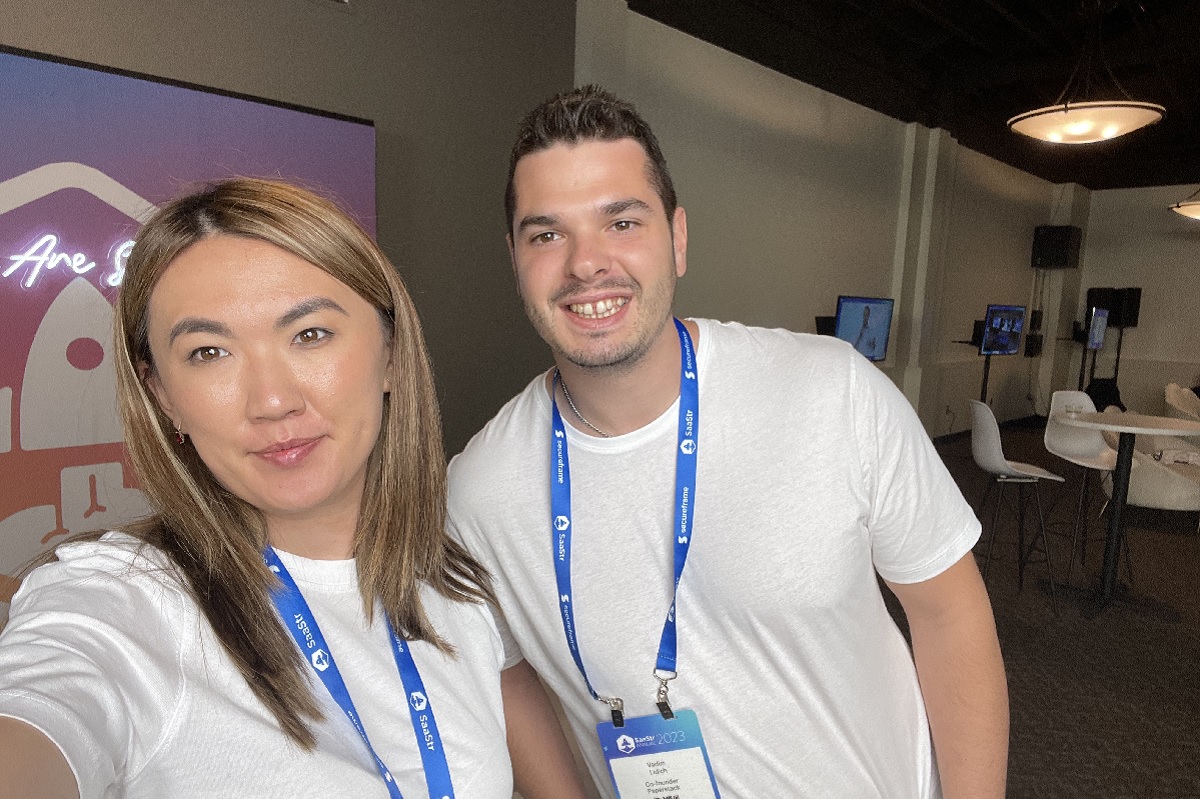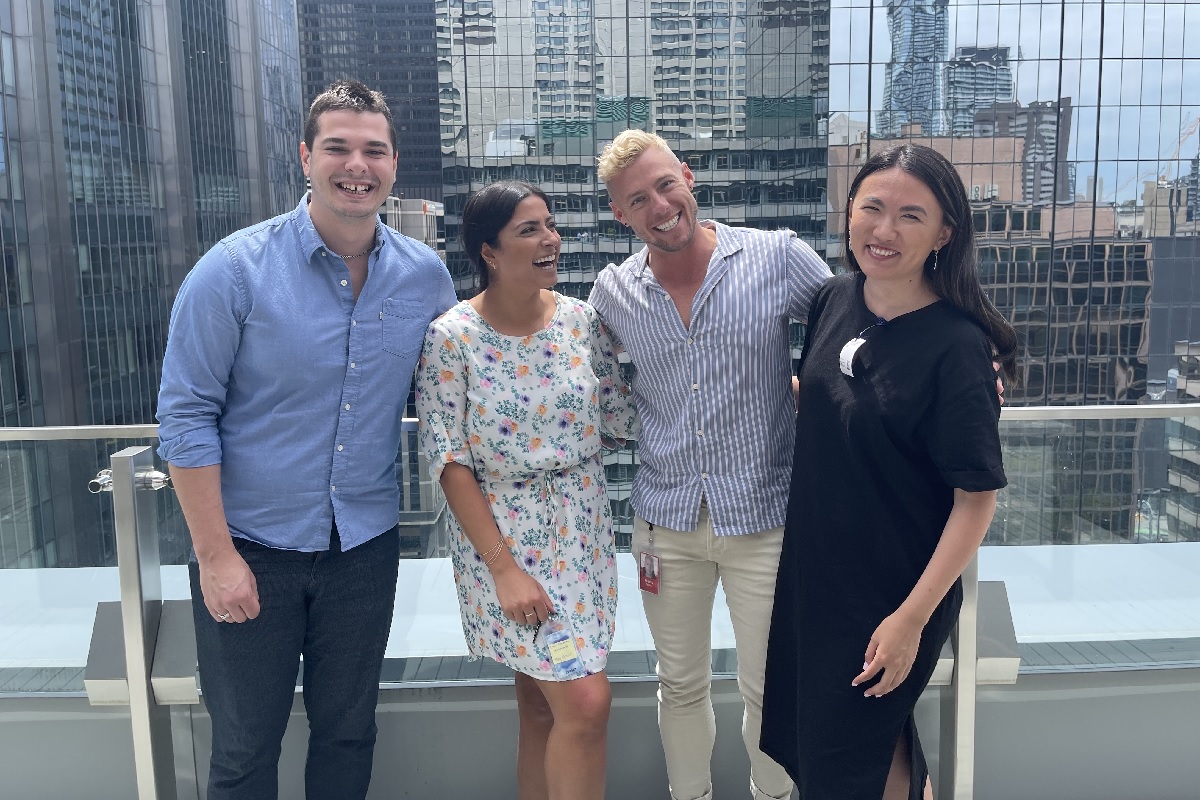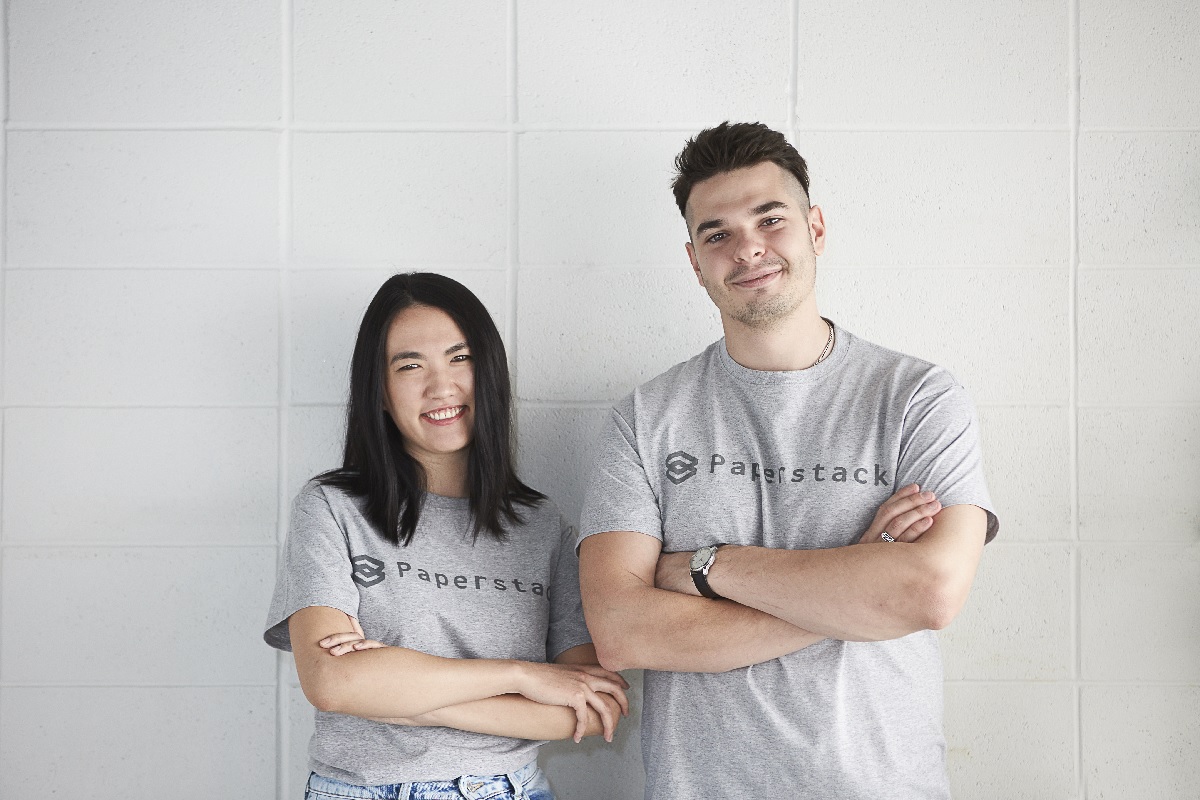Ultimately, Asel found her path when she gained acceptance to Seneca College in Toronto. There, she successfully earned a degree in finance. Following her graduation, she spent several years working in prominent Canadian banks. Eventually, she joined forces with fellow Kazakhstani Vadim Lidich to launch the startup Paperstack. This innovative platform provides online shop owners with the means to secure funding for their operations, including purchasing goods and advertising.
During the interview for the collaborative project between Digital Business and Astana Hub, “100 Startup Stories of Kazakhstan,” Assel discussed her decision to launch an IT startup despite lacking an IT background, the factors that piqued the interest of significant institutional funds in the USA for the joint Kazakhstan-Ukraine project, and the funding potential of an online shop through Paperstack.
“In the early stages of my career, I envisioned myself as an employed worker with aspirations of becoming a Vice President at one of the banks in Canada or the USA”.
– What led to your decision to move to Canada following your experience at Nazarbayev University?
– There were several reasons. Firstly, Canada offers a high standard of education, and upon graduation, you have the opportunity to obtain a work permit. Additionally, foreigners can easily find employment in their respective fields without complications. Secondly, the cost of education is reasonable. For instance, at that time, my college tuition was equivalent to that of Kazakhstan Institute of Management, Economics, and Forecasting (KIMEP).
– You mentioned that during your time as a student, you held positions as an administrator at a Canadian shop and worked as a seller in a flower shop. Besides earning money for personal needs, what benefits did you receive?

– I managed to significantly enhance my English language skills and immerse myself in Canadian slang. This provided me with a more profound insight into the local population: their thoughts, concerns, cultural nuances, and more. Most importantly, I acquired the ability to communicate effectively, set priorities, and plan efficiently. This experience proved to be immensely beneficial in my future endeavors.
– At what point did banking become a part of your life?
– When I was in college, banking entered my life. Towards the end of my studies, I aimed to secure an internship in my field in Canada or the USA. I began searching for part-time jobs, which ultimately led me to a position at a Canadian financial institution.
To be candid, I didn’t initially plan to stay in Canada. I was contemplating opportunities to return to Kazakhstan. However, after completing my internship, I received a job offer in Canada.
– Did you envision yourself as an employed worker?
– I aspired to advance my career in the banking industry. Initially, I held the role of a financial advisor at Scotiabank, which ranks as the third-largest bank in Canada by market capitalization. Subsequently, I continued in the same position at the Canadian Imperial Bank of Commerce (CIBC), the largest financial institution globally. My dream was to attain the position of Vice President at one of the banks in Canada or the USA.
– When did you make the decision to transition into entrepreneurship?
– During my time at CIBC, I observed that the client’s creditworthiness assessment system was not aligned with the current reality and was overly time-consuming. I made the determination that this issue could be resolved through the use of IT. Consequently, I began researching this aspect: attending meetups, engaging with industry experts, and studying how other banks handled this process.
I proposed to the management the idea of initiating the development of a product utilizing AI to expedite the lending process. However, the issue I emphasized was not considered a top priority at that time.

Co-founder and CTO Paperstack Вадим Лидич
Subsequently, I made the decision to take matters into my own hands. I got in touch with my friend from our student days, Vadim, who possessed experience in launching three startups. Together, we outlined a preliminary concept for Paperstack and began the gradual development of the platform.
“The primary challenge for a new e-commerce company lies in the working capital”
– What was the initial concept of Paperstack?
– It served as an accounting system tailored for e-commerce. Our rationale was as follows: online shop owners face numerous daily decisions, including allocating funds for advertising or purchasing goods, buying inventory like red or green t-shirts, determining the quantity of purchases (once, twice, or thrice), and more. By analyzing data, we could provide recommendations to enhance economic performance.
However, in practice, it operated somewhat differently from our initial plans. For instance, we might advise an entrepreneur to invest in marketing, and their response would be, “I’d like to, but I currently don’t have the funds.” Another scenario is when we recommend reducing the frequency of purchasing goods from six times a year to four times but in larger quantities to lower costs. In response, the entrepreneur might say, “Guys, I only buy goods when I’ve accumulated a certain amount in my bank account.”

Subsequently, we came to the realization that the fundamental challenge for a new e-commerce company revolves around working capital. Consequently, we made the decision to adapt our product into a system that offers working capital solutions.
– Is it a form of a loan?
– You are correct. Our experience with the accounting system revealed that online shops frequently resort to loans in two scenarios: to acquire inventory and for advertising purposes. In the first scenario, with the infusion of additional capital, they can place larger orders with producers and negotiate discounts. For instance, while they previously paid $5 for a cup, the price can be reduced to $3.5 when purchasing a substantial quantity.
This approach enables more effective quarterly planning, reducing the need for last-minute inventory orders. Additionally, it eliminates the necessity for air transportation of these cups, opting for more cost-effective sea or land transport.
– Where did your funding come from?
– Regarding the product, our funding was sourced from business angels, including individuals from the fintech, banking, and e-commerce sectors. We successfully concluded our first round of funding, securing $250,000.
This funding sustained us for an extended period. With Vadim’s expertise in technological startups, we had a clear understanding of what pitfalls to avoid, resulting in substantial resource savings. Furthermore, we maintained strict financial discipline, carefully allocating every dollar, and swiftly monetized our accounting system, achieving our initial traction.
Regarding working capital, we opted to collaborate with institutional funds responsible for managing multimillion-dollar portfolios.
– What sparked their interest in funding your venture for providing loans to online shops?
– These funds aim to diversify their investment portfolios, which encompass ventures, the real sector, and other areas. They also express an interest in entering the lending space. However, they lack the expertise and technology required for accurate assessments of individual online shops. Our platform, on the other hand, enables a comprehensive evaluation of the creditworthiness of any business.
– What facilitates your ability to achieve this?
– We establish connections to the store’s banking account, its physical point of sale accounting systems, and the Shopify account. Machine learning models analyze all available data and make predictions about financial indicators based on this information. This enables us to significantly mitigate credit risks.
“A family couple from Toronto secured a contract to supply their popcorn to the Oscars ceremony, all thanks to us.”
– How many lending funds collaborate with Paperstack?
– We have a partnership with a significant fund based in Connecticut, USA. Initially, we began with smaller amounts, but as they witnessed our performance over the course of a year and a half, as well as our portfolio, they made the decision to allocate more funds for working capital.

We had contracts in place with various institutional funds and family offices. Nevertheless, we temporarily halted our negotiations and opted to concentrate on one major partner. However, in the future, as we accumulate more resources, we plan to expand our pool of creditors.
– Who constitutes your main clientele?
– Our primary clients are online shops with a monthly turnover of at least $25,000. The majority of our clients fall within the range of companies with annual turnovers ranging from $1 million to $50 million. In essence, these are businesses that have been operational for 6-8 years and have weathered the challenges posed by the coronavirus pandemic. Many of them operate through multiple sales channels, including websites and physical points of sale in large supermarkets.
For instance, we have an excellent client—a married couple from Toronto who specializes in producing popcorn with flavors like champagne, tequila, whiskey, sangria, and more. Their business has been operational for several years. Last year, with the assistance of our working capital, they secured a contract to supply their popcorn to the Oscars Award ceremony. So, it’s safe to say that I have a connection to Leo Di Caprio through a single handshake.
– What is the funding amount you offer to businesses?
– Initially, the funding amounts are relatively modest, aiming to reduce risks and thoroughly assess the performance of our neural network across a diverse range of businesses. In essence, we invested in online shops dealing with food, cosmetics, clothing, and other sectors to enable artificial intelligence to make the most accurate assessments of their creditworthiness.

Currently, our product is fully operational, and we are capable of offering online shops funding exceeding $1 million for less than one year.
– What is the rate of interest?
– We do not operate with fixed interest rates similar to traditional banks, where you borrow $100,000 at a 10% annual interest rate. Instead, our model revolves around revenue-based financing, where investors provide capital to a business in exchange for a fixed percentage of its current income.
For instance, the fee for a $100,000 loan can vary between $5,000 and $12,000. Consequently, the total repayment amount for the business falls within the range of $105,000 to $112,000. As part of our agreement, an online shop, for example, commits to paying us 7% of its monthly revenue until it settles its debt. One of our objectives is to predict the timeframe within which they will achieve this repayment.
– How do you generate revenue within this model?
– We generate revenue by charging an origination fee (a fee associated with the establishment of an account with the bank, brokerage, or another entity that offers data processing services for loan receipt) and a servicing fee from the lender.
I cannot disclose specific amounts, but we have been consistently profitable for a minimum of four months.

“My primary goal is to elevate the startup to a global scale and position it as a unicorn or even surpass that level of success.”
– You have recently completed the second round of funding, totaling $6.5 million. Can you reveal the identity of the investor?
– The investment came from Gaingels, a New York-based fund known for backing over 20 unicorns. We also received support from one fund through the Techstars accelerator program, in which we were participants. Furthermore, several of our initial investors opted to reinvest in the project. While I can’t disclose the exact amount, it is not in the hundreds of millions of dollars at this stage.

– How do you plan to allocate the funds?
– We intend to utilize the funds to launch our second financial product, which will be offered to our existing clients. Our long-term vision is to centralize all e-commerce monetary transactions through our platform. Working capital has played a pivotal role in building relationships with businesses and establishing our client base. We remain committed to advancing in this direction.
Without boasting, I can confidently label myself as an e-commerce expert. Recently, I’ve dedicated significant time to visiting our partners’ warehouses, which has proven invaluable in gaining a deeper understanding of their operational processes. Engaging with people on the ground has provided insights into procurement planning and preparations for major events such as New Year celebrations. Consequently, I’ve gained access to valuable information that can be leveraged to enhance our own product.

– Are there any plans to expand into additional markets?
– Currently, our primary focus is on Canada and the USA, both of which represent substantial markets. The USA, in particular, boasts the highest number of online shops globally, with millions of them operating here. Our initial strategy is to attain specific performance benchmarks in the USA, optimize operational processes to a high degree, and then contemplate global expansion.
Entering markets like MENA, for instance, would demand significant resources that we do not currently possess. Therefore, our approach will be gradual. Our overarching objective is to establish a global presence for our business.
– Do you have any intentions of launching another startup in Kazakhstan?
– I observe the remarkable progress in the IT sector in Kazakhstan, but I currently have no intentions of launching another startup. Managing two projects simultaneously is physically unfeasible for me. My full dedication, focus, and time are devoted to Paperstack.

I’m constantly in touch with my global team, which includes members from Kazakhstan. Additionally, I maintain ongoing communication with clients who regularly provide intriguing ideas for enhancing the project. My foremost objective is to propel the startup to a global level and establish it as a unicorn or potentially surpass that level of achievement.
Ultimately, Asel found her path when she gained acceptance to Seneca College in Toronto. There, she successfully earned a degree in finance. Following her graduation, she spent several years working in prominent Canadian banks. Eventually, she joined forces with fellow Kazakhstani Vadim Lidich to launch the startup Paperstack. This innovative platform provides online shop owners with the means to secure funding for their operations, including purchasing goods and advertising.
During the interview for the collaborative project between Digital Business and Astana Hub, “100 Startup Stories of Kazakhstan,” Assel discussed her decision to launch an IT startup despite lacking an IT background, the factors that piqued the interest of significant institutional funds in the USA for the joint Kazakhstan-Ukraine project, and the funding potential of an online shop through Paperstack.
“In the early stages of my career, I envisioned myself as an employed worker with aspirations of becoming a Vice President at one of the banks in Canada or the USA”.
– What led to your decision to move to Canada following your experience at Nazarbayev University?
– There were several reasons. Firstly, Canada offers a high standard of education, and upon graduation, you have the opportunity to obtain a work permit. Additionally, foreigners can easily find employment in their respective fields without complications. Secondly, the cost of education is reasonable. For instance, at that time, my college tuition was equivalent to that of Kazakhstan Institute of Management, Economics, and Forecasting (KIMEP).
– You mentioned that during your time as a student, you held positions as an administrator at a Canadian shop and worked as a seller in a flower shop. Besides earning money for personal needs, what benefits did you receive?

– I managed to significantly enhance my English language skills and immerse myself in Canadian slang. This provided me with a more profound insight into the local population: their thoughts, concerns, cultural nuances, and more. Most importantly, I acquired the ability to communicate effectively, set priorities, and plan efficiently. This experience proved to be immensely beneficial in my future endeavors.
– At what point did banking become a part of your life?
– When I was in college, banking entered my life. Towards the end of my studies, I aimed to secure an internship in my field in Canada or the USA. I began searching for part-time jobs, which ultimately led me to a position at a Canadian financial institution.
To be candid, I didn’t initially plan to stay in Canada. I was contemplating opportunities to return to Kazakhstan. However, after completing my internship, I received a job offer in Canada.
– Did you envision yourself as an employed worker?
– I aspired to advance my career in the banking industry. Initially, I held the role of a financial advisor at Scotiabank, which ranks as the third-largest bank in Canada by market capitalization. Subsequently, I continued in the same position at the Canadian Imperial Bank of Commerce (CIBC), the largest financial institution globally. My dream was to attain the position of Vice President at one of the banks in Canada or the USA.
– When did you make the decision to transition into entrepreneurship?
– During my time at CIBC, I observed that the client’s creditworthiness assessment system was not aligned with the current reality and was overly time-consuming. I made the determination that this issue could be resolved through the use of IT. Consequently, I began researching this aspect: attending meetups, engaging with industry experts, and studying how other banks handled this process.
I proposed to the management the idea of initiating the development of a product utilizing AI to expedite the lending process. However, the issue I emphasized was not considered a top priority at that time.

Co-founder and CTO Paperstack Вадим Лидич
Subsequently, I made the decision to take matters into my own hands. I got in touch with my friend from our student days, Vadim, who possessed experience in launching three startups. Together, we outlined a preliminary concept for Paperstack and began the gradual development of the platform.
“The primary challenge for a new e-commerce company lies in the working capital”
– What was the initial concept of Paperstack?
– It served as an accounting system tailored for e-commerce. Our rationale was as follows: online shop owners face numerous daily decisions, including allocating funds for advertising or purchasing goods, buying inventory like red or green t-shirts, determining the quantity of purchases (once, twice, or thrice), and more. By analyzing data, we could provide recommendations to enhance economic performance.
However, in practice, it operated somewhat differently from our initial plans. For instance, we might advise an entrepreneur to invest in marketing, and their response would be, “I’d like to, but I currently don’t have the funds.” Another scenario is when we recommend reducing the frequency of purchasing goods from six times a year to four times but in larger quantities to lower costs. In response, the entrepreneur might say, “Guys, I only buy goods when I’ve accumulated a certain amount in my bank account.”

Subsequently, we came to the realization that the fundamental challenge for a new e-commerce company revolves around working capital. Consequently, we made the decision to adapt our product into a system that offers working capital solutions.
– Is it a form of a loan?
– You are correct. Our experience with the accounting system revealed that online shops frequently resort to loans in two scenarios: to acquire inventory and for advertising purposes. In the first scenario, with the infusion of additional capital, they can place larger orders with producers and negotiate discounts. For instance, while they previously paid $5 for a cup, the price can be reduced to $3.5 when purchasing a substantial quantity.
This approach enables more effective quarterly planning, reducing the need for last-minute inventory orders. Additionally, it eliminates the necessity for air transportation of these cups, opting for more cost-effective sea or land transport.
– Where did your funding come from?
– Regarding the product, our funding was sourced from business angels, including individuals from the fintech, banking, and e-commerce sectors. We successfully concluded our first round of funding, securing $250,000.
This funding sustained us for an extended period. With Vadim’s expertise in technological startups, we had a clear understanding of what pitfalls to avoid, resulting in substantial resource savings. Furthermore, we maintained strict financial discipline, carefully allocating every dollar, and swiftly monetized our accounting system, achieving our initial traction.
Regarding working capital, we opted to collaborate with institutional funds responsible for managing multimillion-dollar portfolios.
– What sparked their interest in funding your venture for providing loans to online shops?
– These funds aim to diversify their investment portfolios, which encompass ventures, the real sector, and other areas. They also express an interest in entering the lending space. However, they lack the expertise and technology required for accurate assessments of individual online shops. Our platform, on the other hand, enables a comprehensive evaluation of the creditworthiness of any business.
– What facilitates your ability to achieve this?
– We establish connections to the store’s banking account, its physical point of sale accounting systems, and the Shopify account. Machine learning models analyze all available data and make predictions about financial indicators based on this information. This enables us to significantly mitigate credit risks.
“A family couple from Toronto secured a contract to supply their popcorn to the Oscars ceremony, all thanks to us.”
– How many lending funds collaborate with Paperstack?
– We have a partnership with a significant fund based in Connecticut, USA. Initially, we began with smaller amounts, but as they witnessed our performance over the course of a year and a half, as well as our portfolio, they made the decision to allocate more funds for working capital.

We had contracts in place with various institutional funds and family offices. Nevertheless, we temporarily halted our negotiations and opted to concentrate on one major partner. However, in the future, as we accumulate more resources, we plan to expand our pool of creditors.
– Who constitutes your main clientele?
– Our primary clients are online shops with a monthly turnover of at least $25,000. The majority of our clients fall within the range of companies with annual turnovers ranging from $1 million to $50 million. In essence, these are businesses that have been operational for 6-8 years and have weathered the challenges posed by the coronavirus pandemic. Many of them operate through multiple sales channels, including websites and physical points of sale in large supermarkets.
For instance, we have an excellent client—a married couple from Toronto who specializes in producing popcorn with flavors like champagne, tequila, whiskey, sangria, and more. Their business has been operational for several years. Last year, with the assistance of our working capital, they secured a contract to supply their popcorn to the Oscars Award ceremony. So, it’s safe to say that I have a connection to Leo Di Caprio through a single handshake.
– What is the funding amount you offer to businesses?
– Initially, the funding amounts are relatively modest, aiming to reduce risks and thoroughly assess the performance of our neural network across a diverse range of businesses. In essence, we invested in online shops dealing with food, cosmetics, clothing, and other sectors to enable artificial intelligence to make the most accurate assessments of their creditworthiness.

Currently, our product is fully operational, and we are capable of offering online shops funding exceeding $1 million for less than one year.
– What is the rate of interest?
– We do not operate with fixed interest rates similar to traditional banks, where you borrow $100,000 at a 10% annual interest rate. Instead, our model revolves around revenue-based financing, where investors provide capital to a business in exchange for a fixed percentage of its current income.
For instance, the fee for a $100,000 loan can vary between $5,000 and $12,000. Consequently, the total repayment amount for the business falls within the range of $105,000 to $112,000. As part of our agreement, an online shop, for example, commits to paying us 7% of its monthly revenue until it settles its debt. One of our objectives is to predict the timeframe within which they will achieve this repayment.
– How do you generate revenue within this model?
– We generate revenue by charging an origination fee (a fee associated with the establishment of an account with the bank, brokerage, or another entity that offers data processing services for loan receipt) and a servicing fee from the lender.
I cannot disclose specific amounts, but we have been consistently profitable for a minimum of four months.

“My primary goal is to elevate the startup to a global scale and position it as a unicorn or even surpass that level of success.”
– You have recently completed the second round of funding, totaling $6.5 million. Can you reveal the identity of the investor?
– The investment came from Gaingels, a New York-based fund known for backing over 20 unicorns. We also received support from one fund through the Techstars accelerator program, in which we were participants. Furthermore, several of our initial investors opted to reinvest in the project. While I can’t disclose the exact amount, it is not in the hundreds of millions of dollars at this stage.

– How do you plan to allocate the funds?
– We intend to utilize the funds to launch our second financial product, which will be offered to our existing clients. Our long-term vision is to centralize all e-commerce monetary transactions through our platform. Working capital has played a pivotal role in building relationships with businesses and establishing our client base. We remain committed to advancing in this direction.
Without boasting, I can confidently label myself as an e-commerce expert. Recently, I’ve dedicated significant time to visiting our partners’ warehouses, which has proven invaluable in gaining a deeper understanding of their operational processes. Engaging with people on the ground has provided insights into procurement planning and preparations for major events such as New Year celebrations. Consequently, I’ve gained access to valuable information that can be leveraged to enhance our own product.

– Are there any plans to expand into additional markets?
– Currently, our primary focus is on Canada and the USA, both of which represent substantial markets. The USA, in particular, boasts the highest number of online shops globally, with millions of them operating here. Our initial strategy is to attain specific performance benchmarks in the USA, optimize operational processes to a high degree, and then contemplate global expansion.
Entering markets like MENA, for instance, would demand significant resources that we do not currently possess. Therefore, our approach will be gradual. Our overarching objective is to establish a global presence for our business.
– Do you have any intentions of launching another startup in Kazakhstan?
– I observe the remarkable progress in the IT sector in Kazakhstan, but I currently have no intentions of launching another startup. Managing two projects simultaneously is physically unfeasible for me. My full dedication, focus, and time are devoted to Paperstack.

I’m constantly in touch with my global team, which includes members from Kazakhstan. Additionally, I maintain ongoing communication with clients who regularly provide intriguing ideas for enhancing the project. My foremost objective is to propel the startup to a global level and establish it as a unicorn or potentially surpass that level of achievement.





